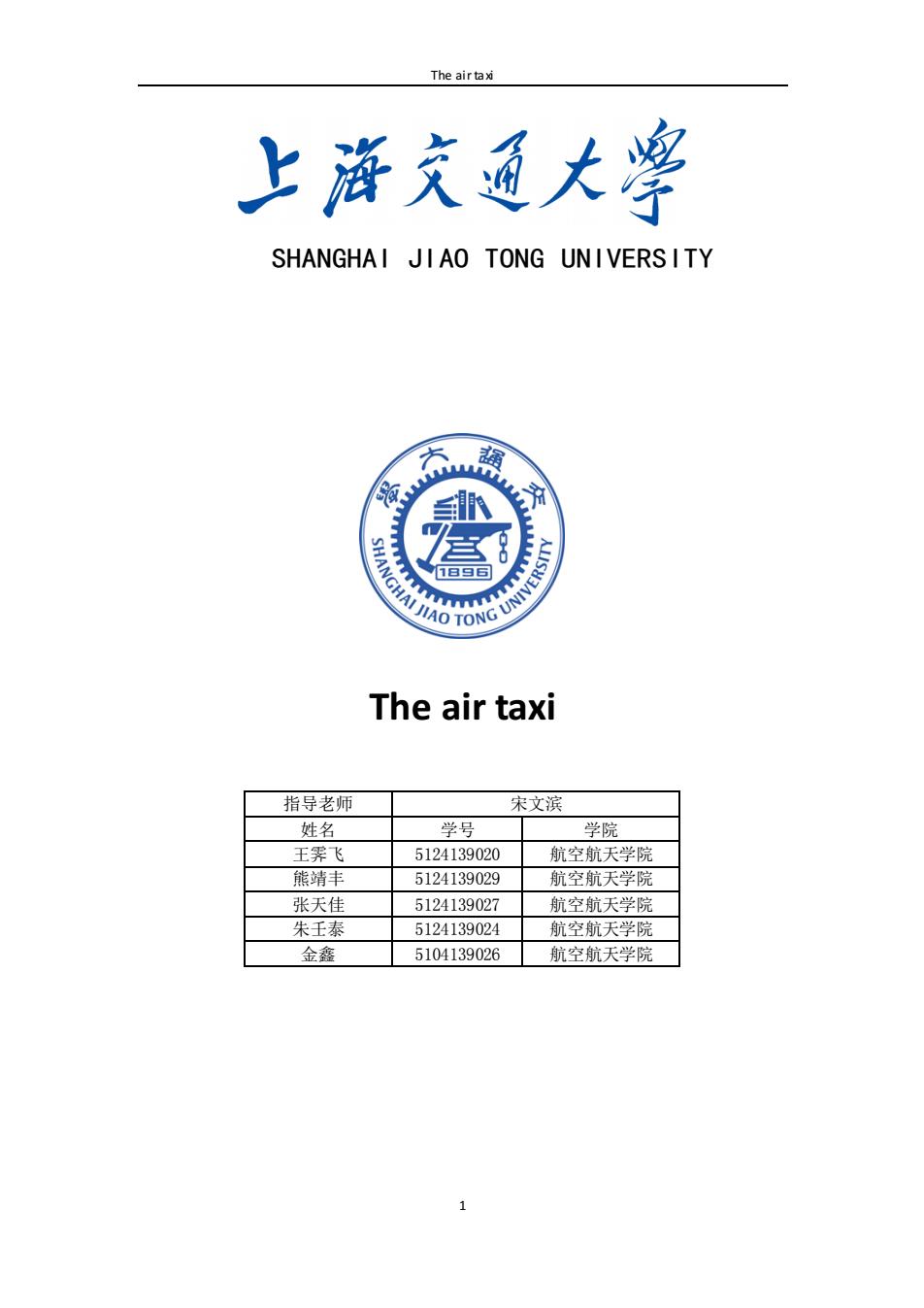
The airtaxi 上游天通大警 SHANGHAI JIAO TONG UNIVERSITY SHANGHALJIAO TONG UNIVERST The air taxi 指导老师 宋文滨 姓名 学号 学院 王霁飞 5124139020 航空航天学院 熊靖丰 5124139029 航空航天学院 张天佳 5124139027 航空航天学院 朱壬泰 5124139024 航空航天学院 金鑫 5104139026 航空航天学院
The air taxi 1 SHANGHAI JIAO TONG UNIVERSITY The air taxi 指导老师 宋文滨 姓名 学号 学院 王霁飞 5124139020 航空航天学院 熊靖丰 5124139029 航空航天学院 张天佳 5124139027 航空航天学院 朱壬泰 5124139024 航空航天学院 金鑫 5104139026 航空航天学院
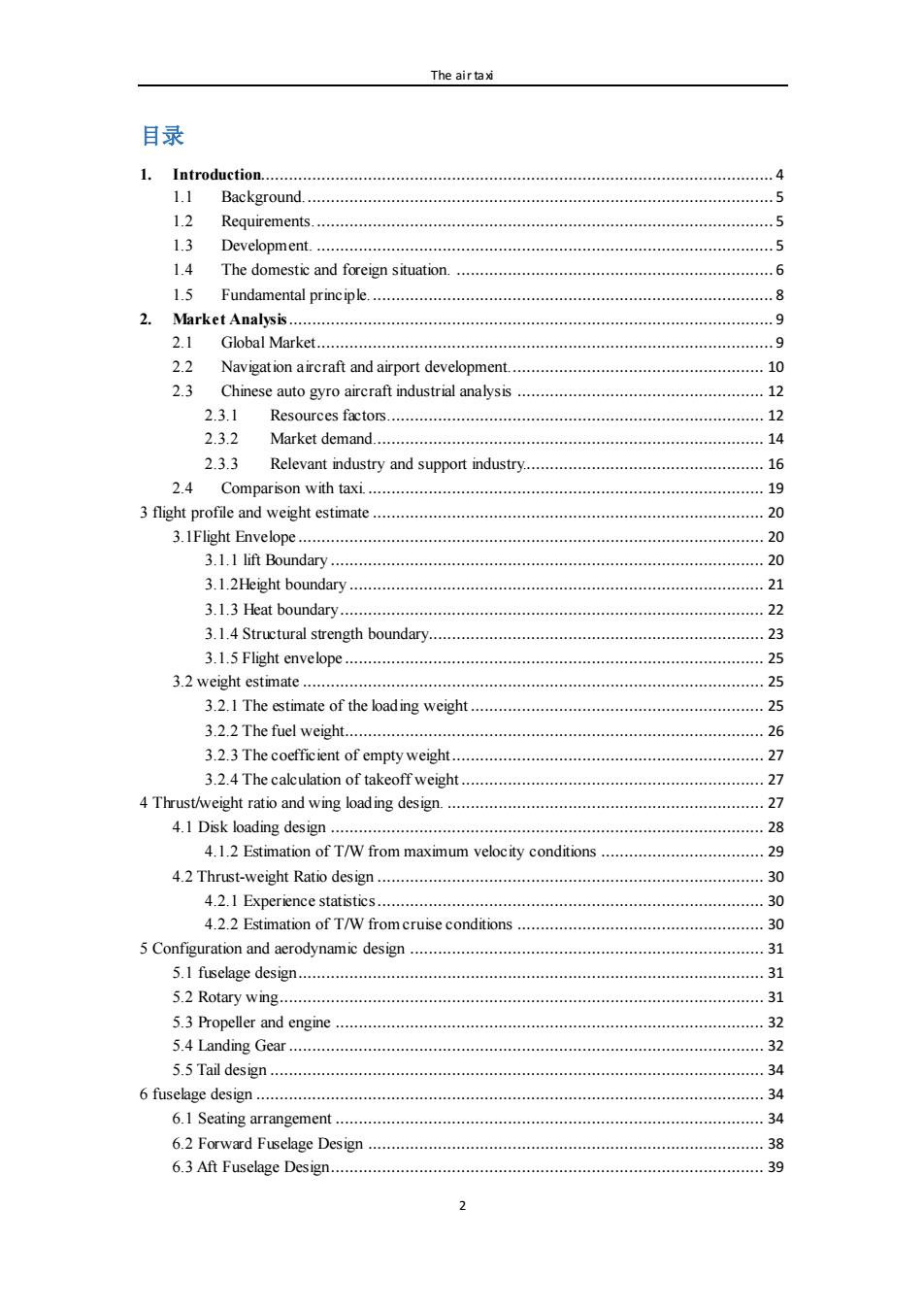
The airta对 目录 1.Introduction..… 4 1.1 Background.… .5 1.2 Requirements.… .5 1.3 Development... .5 1.4 The domestic and foreign situation. .6 1.5 Fundamental principle.. 8 2.Market Ana小sis.… .9 2.1 Global Market..... .9 2.2 Navigation aircraft and airport development.. 10 2.3 Chinese auto gyro aircraft industrial analysis12 2.3.1 Resources factors... 2.3.2 Market demand..… .14 2.3.3 Relevant industry and support industry. .16 2.4 Comparison with taxi 19 3 flight profile and weight estimate............. 20 3.IFlight Envelope... .20 3.1.I lift Boundary. 20 3.1.2Height 3.1.3 Heat boundary...... 22 3.1.4 Structural strength boundary..23 3.1.5 Flight envelope.. 25 3.2 weight estimate... 25 3.2.1 The estimate of the loading weight....... 25 3.2.2 The fuel weight... …26 3.2.3 The coefficient of empty weight.......... 27 3.2.4 The calculation of takeoff weight....... 27 4 Thrust/weight ratio and wing loading design..27 4.I Disk loading design.. 28 4.1.2 Estimation of T/W from maximum velocity conditions.9 4.2 Thrust-weight Ratio design.......... 30 4.2.1 Experience statistics.30 4.2.2 Estimation of T/W from cruise conditions 30 5 Configuration and aerodynamic design ......... …31 5.I fuselage design..... 31 5.2 Rotary wing.… 31 5.3 Propeller and engine....... 32 5.4 Landing Gear........ 32 5.5 Tail design.… 34 6 fuselage design.. 34 6.1 Seating arrangement ........... .34 6.2 Forward Fuselage Design 38 6.3 Aft Fuselage Design............. …39
The air taxi 2 目录 1. Introduction.............................................................................................................. 4 1.1 Background..................................................................................................... 5 1.2 Requirements................................................................................................... 5 1.3 Development. .................................................................................................. 5 1.4 The domestic and foreign situation. .................................................................... 6 1.5 Fundamental principle....................................................................................... 8 2. Market Analysis........................................................................................................ 9 2.1 Global Market.................................................................................................. 9 2.2 Navigation aircraft and airport development....................................................... 10 2.3 Chinese auto gyro aircraft industrial analysis ..................................................... 12 2.3.1 Resources factors................................................................................. 12 2.3.2 Market demand.................................................................................... 14 2.3.3 Relevant industry and support industry.................................................... 16 2.4 Comparison with taxi...................................................................................... 19 3 flight profile and weight estimate .................................................................................... 20 3.1Flight Envelope .................................................................................................... 20 3.1.1 lift Boundary ............................................................................................. 20 3.1.2Height boundary ......................................................................................... 21 3.1.3 Heat boundary........................................................................................... 22 3.1.4 Structural strength boundary........................................................................ 23 3.1.5 Flight envelope .......................................................................................... 25 3.2 weight estimate ................................................................................................... 25 3.2.1 The estimate of the loading weight ............................................................... 25 3.2.2 The fuel weight.......................................................................................... 26 3.2.3 The coefficient of empty weight................................................................... 27 3.2.4 The calculation of takeoff weight ................................................................. 27 4 Thrust/weight ratio and wing loading design. .................................................................... 27 4.1 Disk loading design ............................................................................................. 28 4.1.2 Estimation of T/W from maximum velocity conditions ................................... 29 4.2 Thrust-weight Ratio design ................................................................................... 30 4.2.1 Experience statistics................................................................................... 30 4.2.2 Estimation of T/W from cruise conditions ..................................................... 30 5 Configuration and aerodynamic design ............................................................................ 31 5.1 fuselage design.................................................................................................... 31 5.2 Rotary wing........................................................................................................ 31 5.3 Propeller and engine ............................................................................................ 32 5.4 Landing Gear ...................................................................................................... 32 5.5 Tail design .......................................................................................................... 34 6 fuselage design ............................................................................................................. 34 6.1 Seating arrangement ............................................................................................ 34 6.2 Forward Fuselage Design ..................................................................................... 38 6.3 Aft Fuselage Design............................................................................................. 39
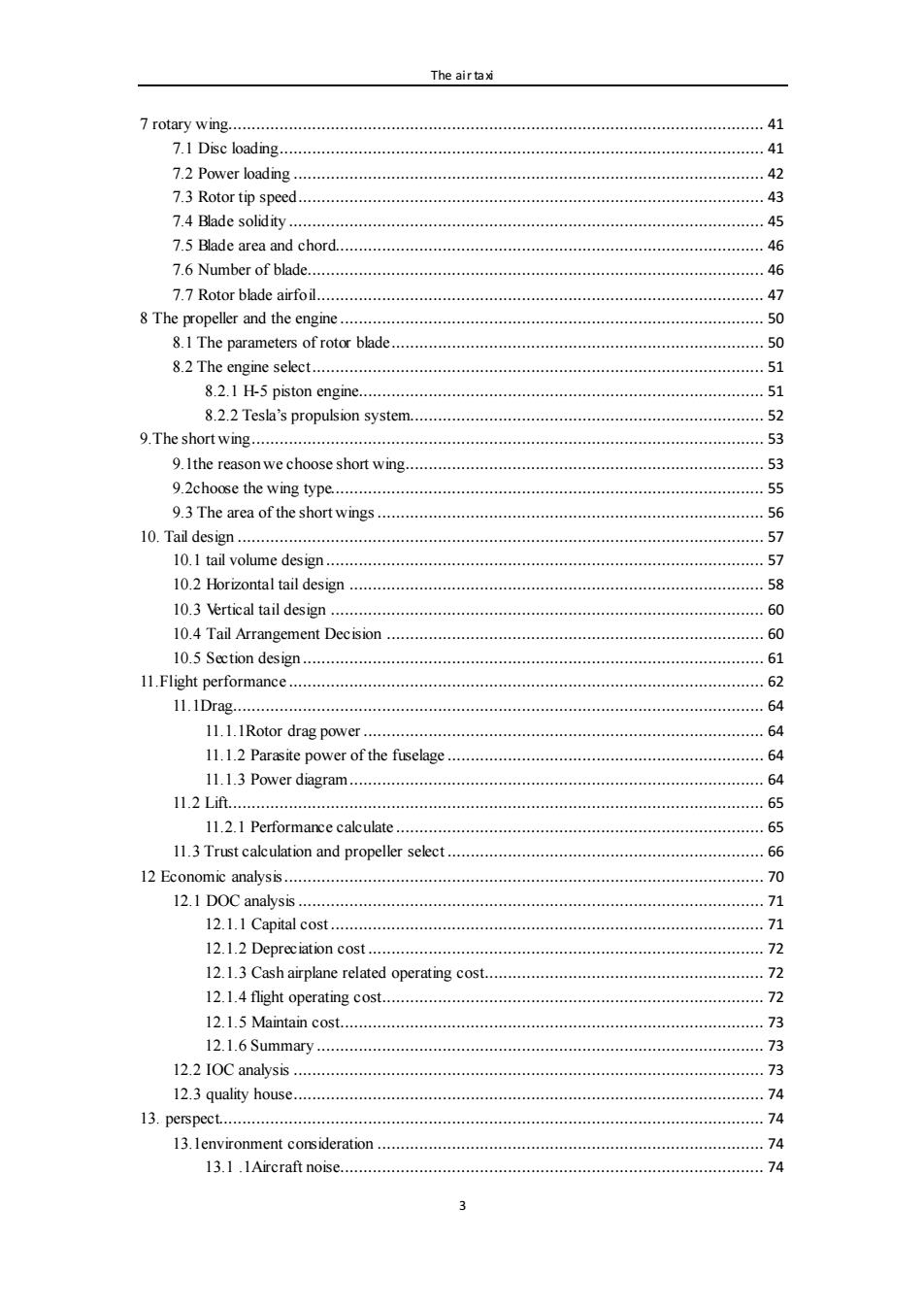
The airta对 7 rotary wing.… 41 7.1 Disc loading.… 41 7.2 Power loading. 42 7.3 Rotor tip speed... 形 7.4 Blade solidity............. 45 7.5 Blade area and chord.. 46 7.6 Number of blade........... 46 7.7 Rotor blade airfoil............. % 8 The propeller and the engine............. 50 8.1 The parameters of rotor blade. 50 8.2 The engine select..... 51 8.2.1 H-5 piston engine.............. 51 8.2.2 Tesla's propulsion system.. 52 9.The short wing.… .53 9.Ithe reason we choose short wing 53 9.2choose the wing type........... 55 9.3 The area of the short wings... .56 l0.Tail design.… .57 10.1 tail volume design........... 57 10.2 Horizontal tail design... 58 10.3 Vertical tail design.... 60 10.4 Tail Arrangement Decision.. 60 l0.5 Section design.… 61 11.Flight performance...... .62 11.IDrag.. 64 11.1.1Rotor drag power....... 64 11.1.2 Parasite power of the fuselage 64 11.1.3 Power diagram.......... 64 11.2Lif.… 65 11.2.1 Performance calculate......... 65 11.3 Trust calculation and propeller select... 66 12 Economic analysis...... 70 12.1 DOC analysis.… 之 12.1.1 Capital cost........ 71 12.1.2 Depreciation cost...... 72 12.1.3 Cash airplane related operating cost. 72 12.1.4 flight operating cost....... 72 12.1.5 Maintain cost.... 73 12.1.6 Summary.... 73 12.2 IOC analysis… 73 12.3 quality house...... 74 l3.perspect.… 74 13.lenvironment consideration 74 13.1.1Aircraft noise........... 74
The air taxi 3 7 rotary wing................................................................................................................... 41 7.1 Disc loading........................................................................................................ 41 7.2 Power loading ..................................................................................................... 42 7.3 Rotor tip speed.................................................................................................... 43 7.4 Blade solidity ...................................................................................................... 45 7.5 Blade area and chord............................................................................................ 46 7.6 Number of blade.................................................................................................. 46 7.7 Rotor blade airfoil................................................................................................ 47 8 The propeller and the engine ........................................................................................... 50 8.1 The parameters of rotor blade................................................................................ 50 8.2 The engine select................................................................................................. 51 8.2.1 H-5 piston engine....................................................................................... 51 8.2.2 Tesla’s propulsion system............................................................................ 52 9.The short wing.............................................................................................................. 53 9.1the reason we choose short wing............................................................................. 53 9.2choose the wing type............................................................................................. 55 9.3 The area of the short wings ................................................................................... 56 10. Tail design ................................................................................................................. 57 10.1 tail volume design .............................................................................................. 57 10.2 Horizontal tail design ......................................................................................... 58 10.3 Vertical tail design ............................................................................................. 60 10.4 Tail Arrangement Decision ................................................................................. 60 10.5 Section design ................................................................................................... 61 11.Flight performance ...................................................................................................... 62 11.1Drag.................................................................................................................. 64 11.1.1Rotor drag power ...................................................................................... 64 11.1.2 Parasite power of the fuselage .................................................................... 64 11.1.3 Power diagram......................................................................................... 64 11.2 Lift................................................................................................................... 65 11.2.1 Performance calculate ............................................................................... 65 11.3 Trust calculation and propeller select .................................................................... 66 12 Economic analysis....................................................................................................... 70 12.1 DOC analysis .................................................................................................... 71 12.1.1 Capital cost ............................................................................................. 71 12.1.2 Depreciation cost ..................................................................................... 72 12.1.3 Cash airplane related operating cost............................................................ 72 12.1.4 flight operating cost.................................................................................. 72 12.1.5 Maintain cost........................................................................................... 73 12.1.6 Summary ................................................................................................ 73 12.2 IOC analysis ..................................................................................................... 73 12.3 quality house..................................................................................................... 74 13. perspect..................................................................................................................... 74 13.1environment consideration ................................................................................... 74 13.1 .1Aircraft noise........................................................................................... 74
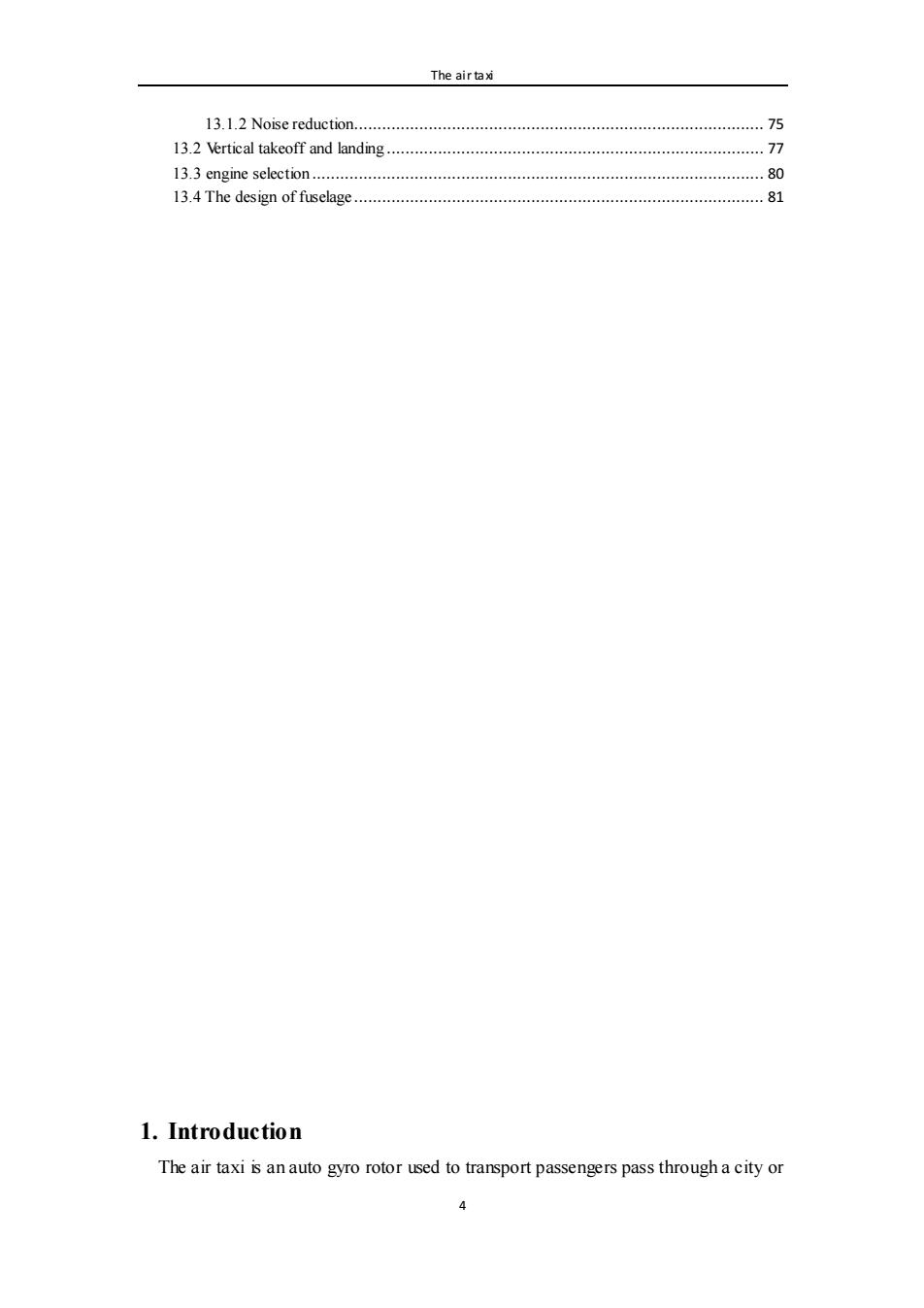
The airta对 13.1.2 Noise reduction................................................75 13.2 Vertical takeoff and landing.. 13.3 engine selection......... 80 13.4 The design of fuselage............... .81 1.Introduction The air taxi is an auto gyro rotor used to transport passengers pass through a city or
The air taxi 4 13.1.2 Noise reduction........................................................................................ 75 13.2 Vertical takeoff and landing ................................................................................. 77 13.3 engine selection ................................................................................................. 80 13.4 The design of fuselage ........................................................................................ 81 1. Introduction The air taxi is an auto gyro rotor used to transport passengers pass through a city or
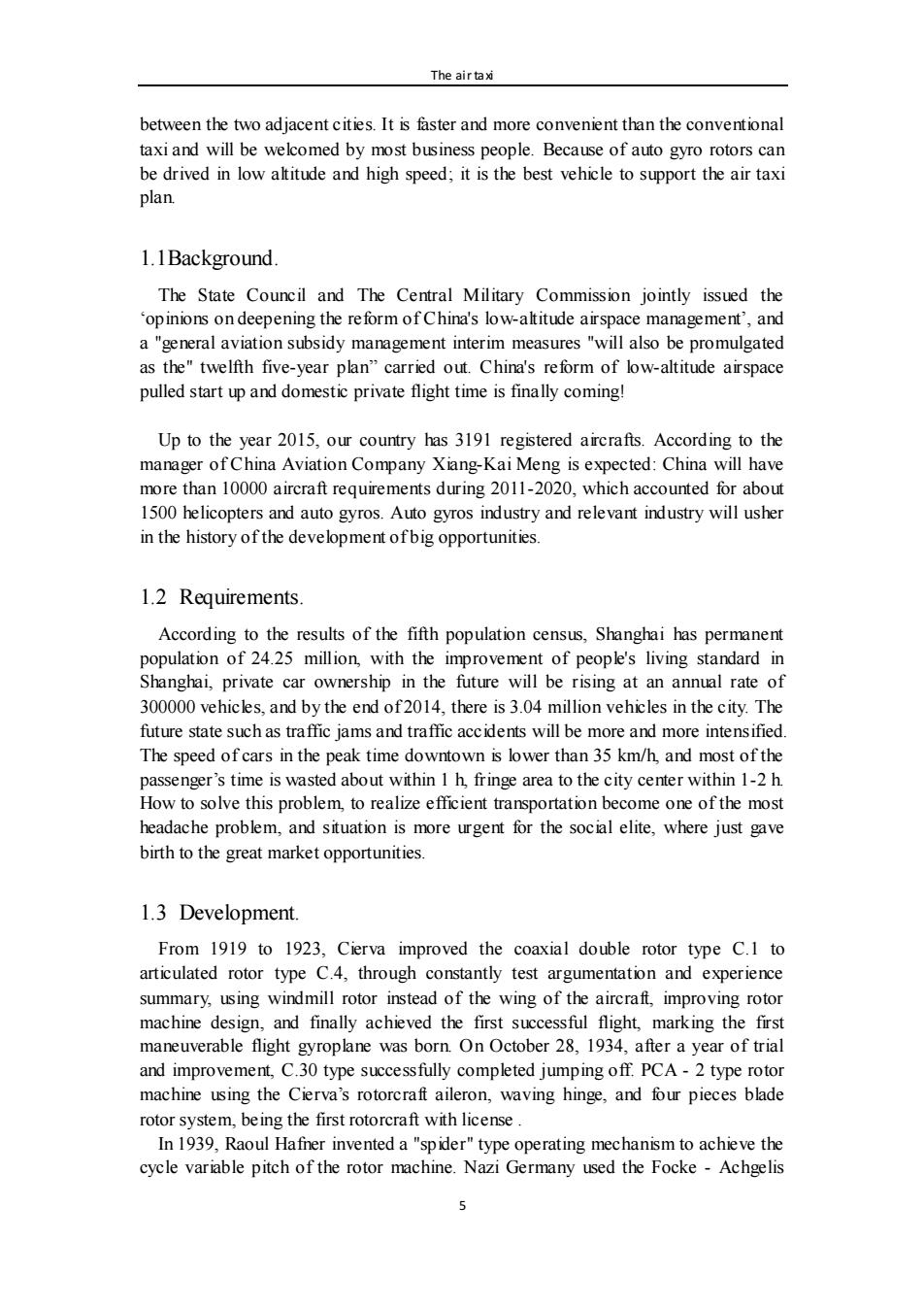
The airta对 between the two adjacent cities.It is faster and more convenient than the conventional taxi and will be welcomed by most business people.Because of auto gyro rotors can be drived in low altitude and high speed;it is the best vehicle to support the air taxi plan. 1.1Background The State Council and The Central Military Commission jointly issued the opinions on deepening the reform of China's low-altitude airspace management',and a "general aviation subsidy management interim measures "will also be promulgated as the"twelfth five-year plan"carried out.China's reform of low-altitude airspace pulled start up and domestic private flight time is finally coming! Up to the year 2015,our country has 3191 registered aircrafts.According to the manager of China Aviation Company Xiang-Kai Meng is expected:China will have more than 10000 aircraft requirements during 2011-2020,which accounted for about 1500 helicopters and auto gyros.Auto gyros industry and relevant industry will usher in the history of the development ofbig opportunities. 1.2 Requirements. According to the results of the fifth population census,Shanghai has permanent population of 24.25 million,with the improvement of people's living standard in Shanghai,private car ownership in the future will be rising at an annual rate of 300000 vehicles,and by the end of 2014,there is 3.04 million vehicles in the city.The future state such as traffic jams and traffic accidents will be more and more intensified. The speed of cars in the peak time downtown is lower than 35 km/h,and most of the passenger's time is wasted about within I h,fringe area to the city center within 1-2 h. How to solve this problem,to realize efficient transportation become one of the most headache problem,and situation is more urgent for the social elite,where just gave birth to the great market opportunities. 1.3 Development. From 1919 to 1923,Cierva improved the coaxial double rotor type C.1 to articulated rotor type C.4,through constantly test argumentation and experience summary,using windmill rotor instead of the wing of the aircraft,improving rotor machine design,and finally achieved the first successful flight,marking the first maneuverable flight gyroplane was born.On October 28,1934,after a year of trial and improvement,C.30 type successfully completed jumping off.PCA-2 type rotor machine using the Cierva's rotorcraft aileron,waving hinge,and four pieces blade rotor system,being the first rotorcraft with license. In 1939,Raoul Hafner invented a "spider"type operating mechanism to achieve the cycle variable pitch of the rotor machine.Nazi Germany used the Focke -Achgelis
The air taxi 5 between the two adjacent cities. It is faster and more convenient than the conventional taxi and will be welcomed by most business people. Because of auto gyro rotors can be drived in low altitude and high speed; it is the best vehicle to support the air taxi plan. 1.1Background. The State Council and The Central Military Commission jointly issued the ‘opinions on deepening the reform of China's low-altitude airspace management’, and a "general aviation subsidy management interim measures "will also be promulgated as the" twelfth five-year plan” carried out. China's reform of low-altitude airspace pulled start up and domestic private flight time is finally coming! Up to the year 2015, our country has 3191 registered aircrafts. According to the manager of China Aviation Company Xiang-Kai Meng is expected: China will have more than 10000 aircraft requirements during 2011-2020, which accounted for about 1500 helicopters and auto gyros. Auto gyros industry and relevant industry will usher in the history of the development of big opportunities. 1.2 Requirements. According to the results of the fifth population census, Shanghai has permanent population of 24.25 million, with the improvement of people's living standard in Shanghai, private car ownership in the future will be rising at an annual rate of 300000 vehicles, and by the end of 2014, there is 3.04 million vehicles in the city. The future state such as traffic jams and traffic accidents will be more and more intensified. The speed of cars in the peak time downtown is lower than 35 km/h, and most of the passenger’s time is wasted about within 1 h, fringe area to the city center within 1-2 h. How to solve this problem, to realize efficient transportation become one of the most headache problem, and situation is more urgent for the social elite, where just gave birth to the great market opportunities. 1.3 Development. From 1919 to 1923, Cierva improved the coaxial double rotor type C.1 to articulated rotor type C.4, through constantly test argumentation and experience summary, using windmill rotor instead of the wing of the aircraft, improving rotor machine design, and finally achieved the first successful flight, marking the first maneuverable flight gyroplane was born. On October 28, 1934, after a year of trial and improvement, C.30 type successfully completed jumping off. PCA - 2 type rotor machine using the Cierva’s rotorcraft aileron, waving hinge, and four pieces blade rotor system, being the first rotorcraft with license . In 1939, Raoul Hafner invented a "spider" type operating mechanism to achieve the cycle variable pitch of the rotor machine. Nazi Germany used the Focke - Achgelis
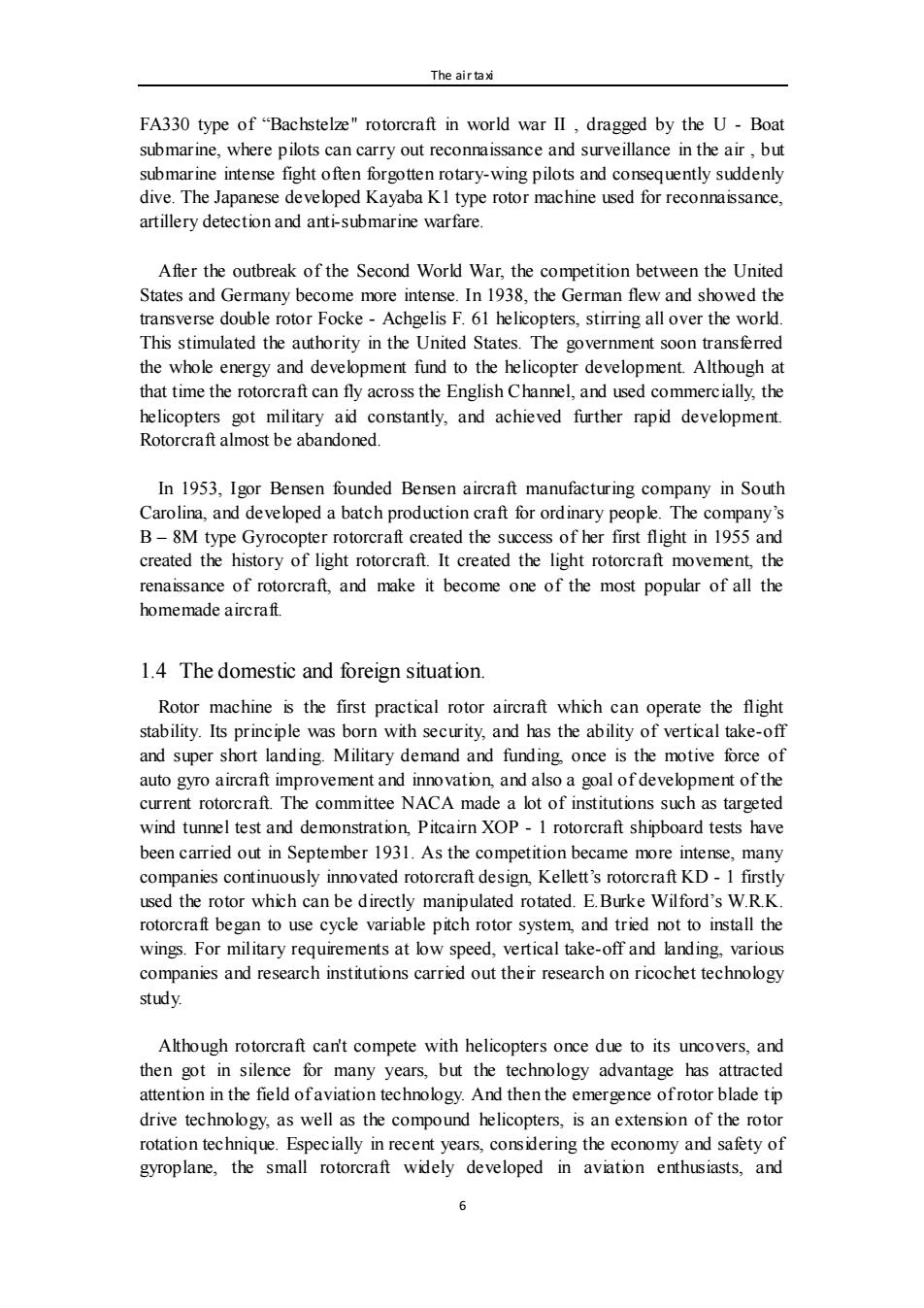
The airta对 FA330 type of"Bachstelze"rotorcraft in world war II,dragged by the U-Boat submarine,where pilots can carry out reconnaissance and surveillance in the air,but submarine intense fight often forgotten rotary-wing pilots and consequently suddenly dive.The Japanese developed Kayaba K1 type rotor machine used for reconnaissance, artillery detection and anti-submarine warfare. After the outbreak of the Second World War,the competition between the United States and Germany become more intense.In 1938,the German flew and showed the transverse double rotor Focke-Achgelis F.61 helicopters,stirring all over the world. This stimulated the authority in the United States.The government soon transferred the whole energy and development fund to the helicopter development.Although at that time the rotorcraft can fly across the English Channel,and used commercially,the helicopters got military aid constantly,and achieved further rapid development. Rotorcraft almost be abandoned. In 1953,Igor Bensen founded Bensen aircraft manufacturing company in South Carolina,and developed a batch production craft for ordinary people.The company's B-8M type Gyrocopter rotorcraft created the success of her first flight in 1955 and created the history of light rotorcraft.It created the light rotorcraft movement,the renaissance of rotorcraft,and make it become one of the most popular of all the homemade aircraft. 1.4 The domestic and foreign situation Rotor machine is the first practical rotor aircraft which can operate the flight stability.Its principle was born with security,and has the ability of vertical take-off and super short landing.Military demand and funding,once is the motive force of auto gyro aircraft improvement and innovation,and also a goal of development of the current rotorcraft.The committee NACA made a lot of institutions such as targeted wind tunnel test and demonstration,Pitcairn XOP-1 rotorcraft shipboard tests have been carried out in September 1931.As the competition became more intense,many companies continuously innovated rotorcraft design,Kellett's rotorcraft KD-1 firstly used the rotor which can be directly manipulated rotated.E.Burke Wilford's W.R.K. rotorcraft began to use cycle variable pitch rotor system,and tried not to install the wings.For military requirements at low speed,vertical take-off and landing,various companies and research institutions carried out their research on ricochet technology study. Although rotorcraft can't compete with helicopters once due to its uncovers,and then got in silence for many years,but the technology advantage has attracted attention in the field ofaviation technology.And then the emergence ofrotor blade tip drive technology,as well as the compound helicopters,is an extension of the rotor rotation technique.Especially in recent years,considering the economy and safety of gyroplane,the small rotorcraft widely developed in aviation enthusiasts,and 6
The air taxi 6 FA330 type of “Bachstelze" rotorcraft in world war II , dragged by the U - Boat submarine, where pilots can carry out reconnaissance and surveillance in the air , but submarine intense fight often forgotten rotary-wing pilots and consequently suddenly dive. The Japanese developed Kayaba K1 type rotor machine used for reconnaissance, artillery detection and anti-submarine warfare. After the outbreak of the Second World War, the competition between the United States and Germany become more intense. In 1938, the German flew and showed the transverse double rotor Focke - Achgelis F. 61 helicopters, stirring all over the world. This stimulated the authority in the United States. The government soon transferred the whole energy and development fund to the helicopter development. Although at that time the rotorcraft can fly across the English Channel, and used commercially, the helicopters got military aid constantly, and achieved further rapid development. Rotorcraft almost be abandoned. In 1953, Igor Bensen founded Bensen aircraft manufacturing company in South Carolina, and developed a batch production craft for ordinary people. The company’s B – 8M type Gyrocopter rotorcraft created the success of her first flight in 1955 and created the history of light rotorcraft. It created the light rotorcraft movement, the renaissance of rotorcraft, and make it become one of the most popular of all the homemade aircraft. 1.4 The domestic and foreign situation. Rotor machine is the first practical rotor aircraft which can operate the flight stability. Its principle was born with security, and has the ability of vertical take-off and super short landing. Military demand and funding, once is the motive force of auto gyro aircraft improvement and innovation, and also a goal of development of the current rotorcraft. The committee NACA made a lot of institutions such as targeted wind tunnel test and demonstration, Pitcairn XOP - 1 rotorcraft shipboard tests have been carried out in September 1931. As the competition became more intense, many companies continuously innovated rotorcraft design, Kellett’s rotorcraft KD - 1 firstly used the rotor which can be directly manipulated rotated. E.Burke Wilford’s W.R.K. rotorcraft began to use cycle variable pitch rotor system, and tried not to install the wings. For military requirements at low speed, vertical take-off and landing, various companies and research institutions carried out their research on ricochet technology study. Although rotorcraft can't compete with helicopters once due to its uncovers, and then got in silence for many years, but the technology advantage has attracted attention in the field of aviation technology. And then the emergence of rotor blade tip drive technology, as well as the compound helicopters, is an extension of the rotor rotation technique. Especially in recent years, considering the economy and safety of gyroplane, the small rotorcraft widely developed in aviation enthusiasts, and
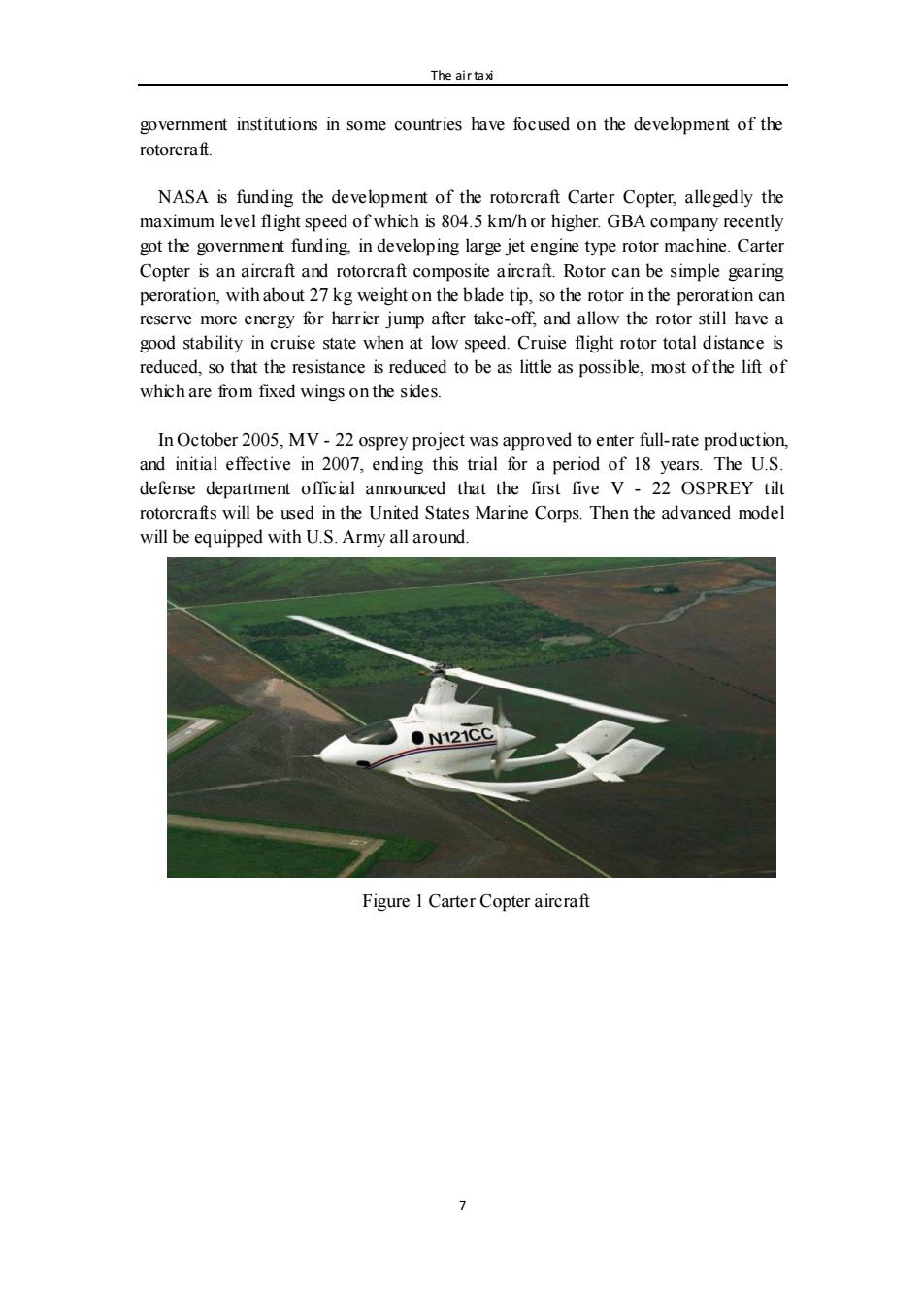
The airta对 government institutions in some countries have focused on the development of the rotorcraft. NASA is funding the development of the rotorcraft Carter Copter,allegedly the maximum level flight speed of which is 804.5 km/h or higher.GBA company recently got the government funding in developing large jet engine type rotor machine.Carter Copter is an aircraft and rotorcraft composite aircraft.Rotor can be simple gearing peroration,with about 27 kg weight on the blade tip,so the rotor in the peroration can reserve more energy for harrier jump after take-off,and allow the rotor still have a good stability in cruise state when at low speed.Cruise flight rotor total distance is reduced,so that the resistance is reduced to be as little as possible,most ofthe lift of which are from fixed wings on the sides. In October 2005,MV-22 osprey project was approved to enter full-rate production, and initial effective in 2007,ending this trial for a period of 18 years.The U.S. defense department official announced that the first five V-22 OSPREY tilt rotorcrafts will be used in the United States Marine Corps.Then the advanced model will be equipped with U.S.Army all around. ●N121CC Figure 1 Carter Copter aircraft 1
The air taxi 7 government institutions in some countries have focused on the development of the rotorcraft. NASA is funding the development of the rotorcraft Carter Copter, allegedly the maximum level flight speed of which is 804.5 km/h or higher. GBA company recently got the government funding, in developing large jet engine type rotor machine. Carter Copter is an aircraft and rotorcraft composite aircraft. Rotor can be simple gearing peroration, with about 27 kg weight on the blade tip, so the rotor in the peroration can reserve more energy for harrier jump after take-off, and allow the rotor still have a good stability in cruise state when at low speed. Cruise flight rotor total distance is reduced, so that the resistance is reduced to be as little as possible, most of the lift of which are from fixed wings on the sides. In October 2005, MV - 22 osprey project was approved to enter full-rate production, and initial effective in 2007, ending this trial for a period of 18 years. The U.S. defense department official announced that the first five V - 22 OSPREY tilt rotorcrafts will be used in the United States Marine Corps. Then the advanced model will be equipped with U.S. Army all around. Figure 1 Carter Copter aircraft

The airtaxi Figure 2 V-22 OSPREY tilt rotorcrafts Rotorcraft is still a rare aircraft in China,especially large and medium-sized rotorcraft,of which markets,using fields and development model is almost a blank Rotor aerodynamic characteristics study is rare,the only research is led by professor Gao Zhen's team on the aerodynamic characteristics of helicopter rotor rotation on exploring the research,and introduced abroad in cooperation with the military and civilian battalion company small rotorcraft,accumulated a certain amount of rotor machine design and the use ofengineering experience. 1.5 Fundamental principle Gyroplane is a kind of rotor aircraft using rotor as the propeller lifting surface, push/pull or other means ofenergy as power. 一 力 高合器 顾转传动绳件 粥编发动机 层传动输 飞轮组件(商合器)主传动铺 发动机 Figure 3 a)typical helicopter b)typical medium to large-scale gyroplane From the appearance,gyroplane and helicopters are very similar,they are equipped with a pair of big rotor above the fuselage;there are also some small fixed wing and fuselage,tail,landing gear,and power plant.Gyroplane remains the state of rotation relying on the flow moving ahead,so once the engine parking in the air,it can directly landing rely on the rotor rotation,while the helicopter rotor need a shift into the process of rotation manipulation,so gyroplane doesn't have avoiding area at low
The air taxi 8 Figure 2 V - 22 OSPREY tilt rotorcrafts Rotorcraft is still a rare aircraft in China, especially large and medium-sized rotorcraft, of which markets, using fields and development model is almost a blank. Rotor aerodynamic characteristics study is rare, the only research is led by professor Gao Zhen’s team on the aerodynamic characteristics of helicopter rotor rotation on exploring the research, and introduced abroad in cooperation with the military and civilian battalion company small rotorcraft, accumulated a certain amount of rotor machine design and the use of engineering experience. 1.5 Fundamental principle. Gyroplane is a kind of rotor aircraft using rotor as the propeller lifting surface, push/pull or other means of energy as power. Figure 3 a) typical helicopter b)typical medium to large-scale gyroplane From the appearance, gyroplane and helicopters are very similar, they are equipped with a pair of big rotor above the fuselage; there are also some small fixed wing and fuselage, tail, landing gear, and power plant. Gyroplane remains the state of rotation relying on the flow moving ahead, so once the engine parking in the air, it can directly landing rely on the rotor rotation, while the helicopter rotor need a shift into the process of rotation manipulation, so gyroplane doesn't have avoiding area at low
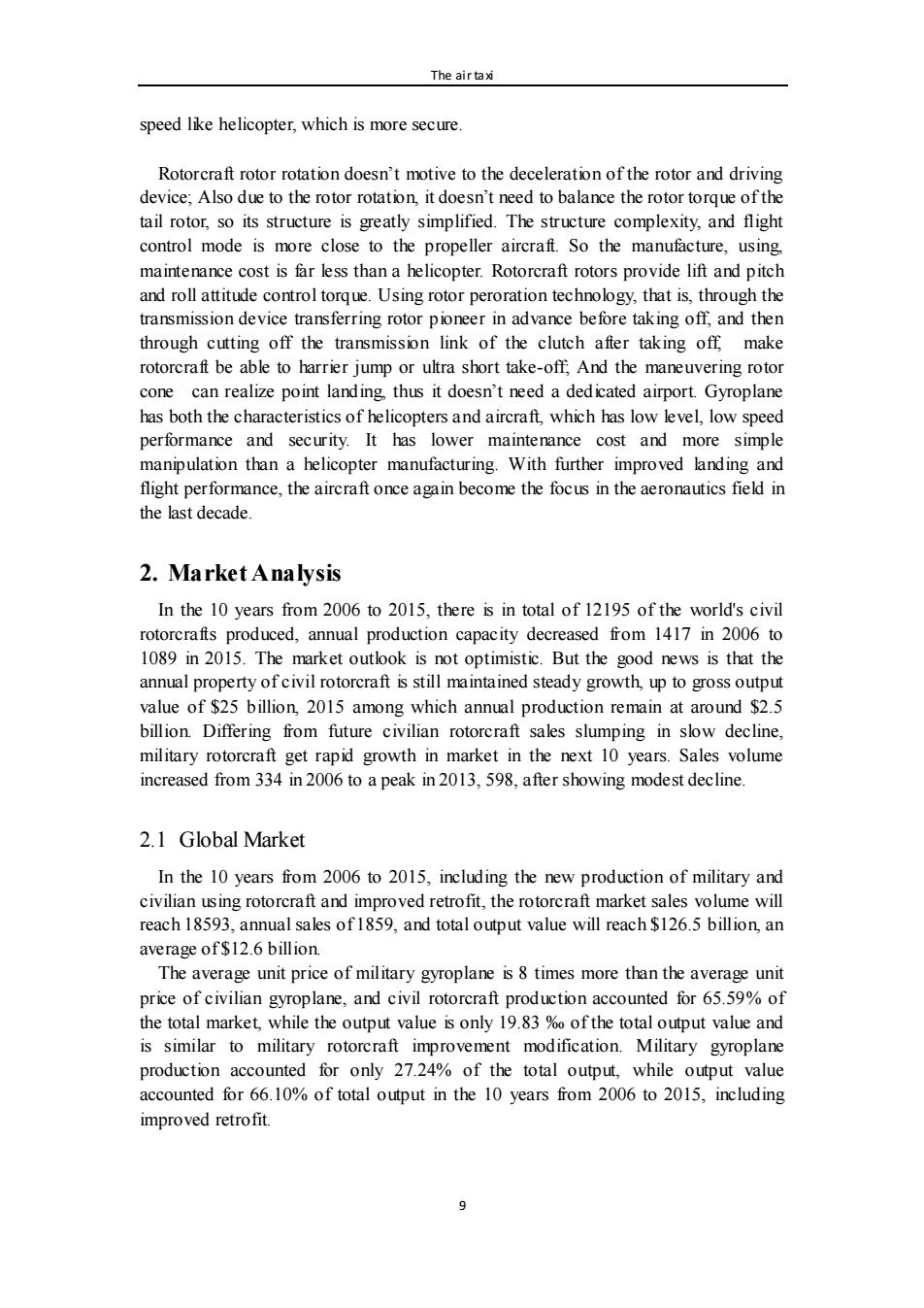
The airta对 speed like helicopter,which is more secure. Rotorcraft rotor rotation doesn't motive to the deceleration of the rotor and driving device;Also due to the rotor rotation,it doesn't need to balance the rotor torque of the tail rotor,so its structure is greatly simplified.The structure complexity,and flight control mode is more close to the propeller aircraft.So the manufacture,using maintenance cost is far less than a helicopter.Rotorcraft rotors provide lift and pitch and roll attitude control torque.Using rotor peroration technology,that is,through the transmission device transferring rotor pioneer in advance before taking off,and then through cutting off the transmission link of the clutch after taking off make rotorcraft be able to harrier jump or ultra short take-off;And the maneuvering rotor cone can realize point landing,thus it doesn't need a dedicated airport.Gyroplane has both the characteristics of helicopters and aircraft,which has low level,low speed performance and security.It has lower maintenance cost and more simple manipulation than a helicopter manufacturing.With further improved landing and flight performance,the aircraft once again become the focus in the aeronautics field in the last decade. 2.Market Analysis In the 10 years from 2006 to 2015,there is in total of 12195 of the world's civil rotorcrafts produced,annual production capacity decreased from 1417 in 2006 to 1089 in 2015.The market outlook is not optimistic.But the good news is that the annual property ofcivil rotorcraft is still maintained steady growth,up to gross output value of $25 billion,2015 among which annual production remain at around $2.5 billion.Differing from future civilian rotorcraft sales slumping in slow decline, military rotorcraft get rapid growth in market in the next 10 years.Sales volume increased from 334 in 2006 to a peak in 2013,598,after showing modest decline 2.1 Global Market In the 10 years from 2006 to 2015,including the new production of military and civilian using rotorcraft and improved retrofit,the rotorcraft market sales volume will reach 18593,annual sales of 1859,and total output value will reach $126.5 billion,an average of$12.6 billion. The average unit price of military gyroplane is 8 times more than the average unit price of civilian gyroplane,and civil rotorcraft production accounted for 65.59%of the total market,while the output value is only 19.83 %0 of the total output value and is similar to military rotorcraft improvement modification.Military gyroplane production accounted for only 27.24%of the total output,while output value accounted for 66.10%of total output in the 10 years from 2006 to 2015,including improved retrofit
The air taxi 9 speed like helicopter, which is more secure. Rotorcraft rotor rotation doesn’t motive to the deceleration of the rotor and driving device; Also due to the rotor rotation, it doesn’t need to balance the rotor torque of the tail rotor, so its structure is greatly simplified. The structure complexity, and flight control mode is more close to the propeller aircraft. So the manufacture, using, maintenance cost is far less than a helicopter. Rotorcraft rotors provide lift and pitch and roll attitude control torque. Using rotor peroration technology, that is, through the transmission device transferring rotor pioneer in advance before taking off, and then through cutting off the transmission link of the clutch after taking off, make rotorcraft be able to harrier jump or ultra short take-off; And the maneuvering rotor cone can realize point landing, thus it doesn’t need a dedicated airport. Gyroplane has both the characteristics of helicopters and aircraft, which has low level, low speed performance and security. It has lower maintenance cost and more simple manipulation than a helicopter manufacturing. With further improved landing and flight performance, the aircraft once again become the focus in the aeronautics field in the last decade. 2. Market Analysis In the 10 years from 2006 to 2015, there is in total of 12195 of the world's civil rotorcrafts produced, annual production capacity decreased from 1417 in 2006 to 1089 in 2015. The market outlook is not optimistic. But the good news is that the annual property of civil rotorcraft is still maintained steady growth, up to gross output value of $25 billion, 2015 among which annual production remain at around $2.5 billion. Differing from future civilian rotorcraft sales slumping in slow decline, military rotorcraft get rapid growth in market in the next 10 years. Sales volume increased from 334 in 2006 to a peak in 2013, 598, after showing modest decline. 2.1 Global Market In the 10 years from 2006 to 2015, including the new production of military and civilian using rotorcraft and improved retrofit, the rotorcraft market sales volume will reach 18593, annual sales of 1859, and total output value will reach $126.5 billion, an average of $12.6 billion. The average unit price of military gyroplane is 8 times more than the average unit price of civilian gyroplane, and civil rotorcraft production accounted for 65.59% of the total market, while the output value is only 19.83 ‰ of the total output value and is similar to military rotorcraft improvement modification. Military gyroplane production accounted for only 27.24% of the total output, while output value accounted for 66.10% of total output in the 10 years from 2006 to 2015, including improved retrofit

The airta对 3000 1200 2500 1000 2000 800 1500 1000 500 200 0 总计 2006一2015世界民用旋翼机产量(架,改型项目除外) 2006一2015世界军用旋机产量(架,改型项目除外) Figure 4 World wide civil and military gyroplane production in 2006-2015 直% 胶清2济 你/接.6%尔/古% 2005一2010年世界翼机市场份额分布(架,包括主要改型) 2006一2010年世界镜翼机市场份额分布(产值,包括主要改型) Figure 5 Worldwide gyroplane market distributions From the figure,We can find that,the output value of the three former columns mainly are Boeing company engaged in military rotor machine development and production of Sikorsky engaged in large and medium-sized military and civil rotor machine development,and the European helicopter company engaged in military and civil rotor machine development and production.From the point of national and regional distribution,the United States accounts for more than 53% of the total output value of the rotorcraft,while Europe accounts for 31%and 5% in Russia. From the above analysis,no matter from the historical data of yield and output value of rotorcraft or forecast for the next 10 years,the world rotorcraft market basically is still in the giants monopoly of United States and the European,where competition is mainly between them.Including Russia and China,rotorcraft industry development space will be strong compressed from the United States and Europe.The outlook is not optimistic,how to find rotorcraft industry development in our country is what we need to seriously study in the United States and Europe rotorcraft industry giants. 2.2 Navigation aircraft and airport development. The development of navigation aircraft is remarkable in European countries,while is just sprout in China.As the development of air taxi,there will be more civil airport for gyroplane to take off and land and consequently increase the production rate of navigation and then improve the operate environment of air taxi reversely. Currently there is about 340000 navigation aircrafts around the world,and the 10
The air taxi 10 Figure 4 Worldwide civil and military gyroplane production in 2006-2015 Figure 5 Worldwide gyroplane market distributions From the figure, We can find that, the output value of the three former columns mainly are Boeing company engaged in military rotor machine development and production of, Sikorsky engaged in large and medium-sized military and civil rotor machine development, and the European helicopter company engaged in military and civil rotor machine development and production. From the point of national and regional distribution, the United States accounts for more than 53% of the total output value of the rotorcraft, while Europe accounts for 31% and 5% in Russia. From the above analysis, no matter from the historical data of yield and output value of rotorcraft or forecast for the next 10 years, the world rotorcraft market basically is still in the giants monopoly of United States and the European, where competition is mainly between them. Including Russia and China, rotorcraft industry development space will be strong compressed from the United States and Europe. The outlook is not optimistic, how to find rotorcraft industry development in our country is what we need to seriously study in the United States and Europe rotorcraft industry giants. 2.2 Navigation aircraft and airport development. The development of navigation aircraft is remarkable in European countries, while is just sprout in China. As the development of air taxi, there will be more civil airport for gyroplane to take off and land and consequently increase the production rate of navigation and then improve the operate environment of air taxi reversely. Currently there is about 340000 navigation aircrafts around the world, and the